Article from: 99percentblog
Between 2010-2011 there were 78 stabbings in Southwark alone, 93 in Lambeth 60 in Lewisham. As official reports suggest, the figures are increasingly concerning. However, arguably the actual numbers, considering unreported crimes, are much higher and the problem is much more wide spread and complex than it initially appears. We are constantly told knife crime is a high priority for government and local authorities, but many tried and tested methods including Stop and Search are simply ineffective. Knife crime is becoming a more prevalent part of our society and clearly we need to adopt a new approach if we are to witness a reduction in knife crime.
For many, the recurrent articles about another young person being stabbed in one of London’s more notorious boroughs seems like a regular occurrence; so much so that it probably fails to have much effect anymore. Another young person’s life lost because of an argument over territory, a stolen blackberry or in one case, some conkers. As well as the endless stories and statistics relating to knife crime, it seems multiple campaigns have appeared and disappeared, with little or short term effect. Still, the problem persists and the question remains: why do so many young Londoners continue to carry knives?
The Peabody Staying Safe Project funded by The Big Lottery has worked with over 100 young people across London to form Campaign Leadership Teams to raise awareness amongst young people about the impact of crime and violence. The Campaign Leadership Teams have set up campaigns, delivered workshops to over 600 young people and created apps, posters and other initiatives to keep young Londoners safe.
One particular Campaign Leadership Team, Faces in Focus, based in Southwark is working in partnership with Peabody and Connexions to produce the original and powerful ‘Choose Life Drop the Knife’ poster as part of the ‘Your Choice, Your Future’ campaign, which was launched at the Art Against Knives Gallery in Shoreditch.
The group, all aged 16 – 19 want to convey their direct message in no uncertain terms. As young men who have all had first-hand experience of knife crime and its’ consequences, they now want to use their experiences to help increase understanding and awareness amongst other young people about the dangers of carrying a knife.
Tanvir explains:
“We grew up in a nice local community in Southwark; the area we mostly used to chill was called Rockingham. Last year nine stabbings happened in our area, these affected all of us. We wanted to make a change and educate young people about knife crime. We started by making two films based on peer pressure and gang culture, named Pressure 1 and Pressure 2 – we formed a larger group once we gained good feedback from different organisations including the local council, Connexions, Vinspired. We wanted to create a poster where we can show people there are two negative conclusions to knife crime, prison or death.
We hope the campaign will be distributed throughout London in bus stops, train stations, schools, local councils, shops and Youth Offending Teams. We want everyone to talk about our campaign and we want our poster to open young peoples’ eyes and make them realise that life is too precious to waste. We are young people – we all individually know someone who has been stabbed or have been stabbed ourselves. Some of us have been a part of knife crime and we realised if we don’t change – we can’t help other people change.
Our campaign is hard-hitting, brutal, honest, realistic and obvious. We want young people to see our posters and realise knife crime is a cycle, it’s an old story – we want to educate and tell everyone how knife crime can affect so many different people. We want to show young people being involved in knife crime is a choice – following the crowd and doing things that others do just to gain reputation, it is a choice that will only end in prison or death.”
Now that the boys have the foundations of their campaign and an incredible visual, thought provoking poster, they are hoping to spread their message as far as possible by presenting in schools, youth clubs, YOTs, youth organisations and charities. The campaign’s uniqueness is apparent when the boys talk about their individual journeys. Possibly because this campaign comes from the mouths’ of those who actually understand the detrimental and deceptive nature of knife crime and gang culture, it will resonate more profoundly with young impressionable Londoners.
As well as educating young people before they become involved in knife crime, the campaign is also a platform to show other young people who have been caught in the criminal justice system that it is not too late to alter their perceptions; after all, the boys openly admit they have made some wrong decisions previously. Not only are they now clearly cutting ties concerning the past, they are looking forward to their campaign continuing to expand. By speaking directly to young people they are clearly placing the responsibility back in the hands of young people themselves.
They aren’t speaking in code it really is very simple: your choice, your future.
By Isabel Chapman & Tanvir Hussain, Shabir Ali, Inanc Arslan, Kaium Abdul, Ediz Pilot, Sayem Samad, Sayim Hussain, Abu-Mukid Jahid, Hanif Hussain
Find out more at www.yourchoiceyourfuture.org
For further information please contact Andrew Bindi at Peabody, Staying Safe Co-ordinator: andrew.bindi@peabody.org.uk |
020 7021 4092
Bibliography
Guardian. 2012. London knife crime: how bad is it? [online] [Accessed 12th May 2012] Available from:
http://www.guardian.co.uk/uk/datablog/2012/apr/12/london-knife-crime
Guardian. 2012. Teenager found guilty of murder after conkers row. [online] [Accessed 30th May 2012] Available from:
http://www.guardian.co.uk/uk/2012/may/16/teenager-found-guilty-murder-conkers?INTCMP=ILCNETTXT3487
*All views expressed in this article are the author’s. IARS accepts no responsibility for the accuracy, completeness, suitability, or validity of any views expressed in these articles and will not be liable for any errors or omissions in this information or any losses or damages arising from its display or use.


